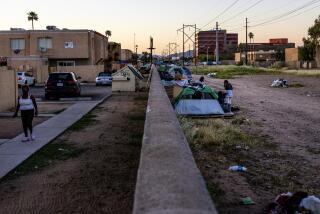A Rebirth, Yes, but Thanks to What?
DETROIT — The gains of Detroit’s empowerment zone can be measured in the yards of blue-and-gray marine tarp heaped on the tables and floor of the Canvas Products Co.
Four years ago, these covers for boats and other watercraft were being made by 50 workers in Oak Park, a suburb just north of Detroit. Now the work’s being done by 90 employees in a renovated 67,000-square-foot factory in the heart of Detroit’s empowerment zone, with many of the new hires coming from the distressed neighborhood itself.
And it’s all taking place within the shadow of Dominga Miles’ girlhood grammar school, which is about to be converted into a senior citizens complex next to another planned housing development.
“I’m glad to see [the neighborhood] . . . coming up again,” said Miles, 59, a Canvas Products worker who moved from the area in 1954. “It was always sad to see it look as bad as it was, because I remember when it was different.”
After more than 30 years of middle-class exodus from Detroit--by whites and blacks, businesses and banks--recent changes to the city’s urban landscape are subtle but tangible.
New housing, virtually unheard-of for a generation, is cropping up in a mix of private and public reinvestment. And new factories are opening, reflecting both renewed commitments by business executives and a sense of faith that maybe Detroit’s future isn’t as gloomy as it once seemed.
A critical question, though, is how much of that change can be traced to the empowerment zone, granted 4 1/2 years ago with the promise of $100 million in federal investment over 10 years.
While defenders of empowerment zones point to Detroit as a success story, others say that the city was already on the verge of change, a psychological shift brought about by several factors.
The main factor was political: Five years ago, combative Mayor Coleman A. Young retired and was succeeded by Dennis Archer, a former state judge well-connected with the business community Young had alienated.
At the same time, the Big Three auto makers were in the early stage of a six-year run of strong sales, just as Chrysler and General Motors recommitted themselves to Detroit.
“It’s an almost metaphysical question to say the empowerment zone has caused what has happened in Detroit,” David J. Wright, director of urban and metropolitan studies at the Rockefeller Institute of Government in Albany, N.Y., who has studied empowerment zones.
“I would be a little reluctant to suggest business decisions of that scale were made based on incentives.”
Similarly, researchers from the University of Michigan recently surveyed about 200 small-business owners in five areas of Detroit’s zone and found only one who had used zone incentives.
“Many didn’t know they were in the zone, and many felt that it was way too complicated to use the incentives,” said Margaret Dewar, an associate professor in the university’s College of Architecture and Urban Planning. “The ones that were well-informed were saying that it wasn’t worth it.”
Yet the empowerment zone has enticed some medium-sized businesses and also drawn together disparate programs to improve everything from day-care service to low-income housing.
Chuck Keersmaekers, whose family businesses include Canvas Products and four other small, Detroit-based textile firms, decided five years ago to consolidate in Oak Park, moving 215 jobs out of the city. But empowerment zone officials changed his mind.
“It wasn’t so much the opportunity to create 30 to 40 new jobs. They didn’t want to lose the ones they had,” he said. “That made it possible to cut a lot of red tape out of the permitting process. We bought the place in shambles, retrofitted it and moved in in six to eight months.”
Not all has been so rosy.
While the federal Department of Housing and Urban Development--which runs the empowerment-zones program nationwide--initially lauded Detroit as a success story, an audit last year by the U.S. Office of Inspector General concluded that Detroit officials had:
* Inaccurately reported the zone’s accomplishments.
* Overstated the level of local matching investments.
* Did not properly control spending of zone funds.
Some $62 million in zone projects have been approved, but only $11.8 million had actually been spent as of April 21. And a lack of follow-up research by administrators makes it impossible to assess how much impact the zone has had.
Some programs are easier to measure than others. An annual $1-million empowerment zone grant supplies the administrative budget for the Family Place, a former library that now houses nine related programs, including a day-care center, two federal Head Start programs, computer-training programs, a family mental health office and a school-funded program for teenagers who are pregnant or are already mothers.
The scope of Detroit’s need is staggering.
Spread over an 18-square-mile area, nearly half the zone’s 101,000 residents and 63% of all children under age 18 live in poverty, according to the city’s empowerment zone application. The official unemployment rate is 29%, though activists say the rate fails to count thousands who have given up hope of finding work.
Death rates from drug abuse and alcoholism in the zone are up to seven times the national rates.
With a citywide population less than half what it was 30 years ago, pheasants roam freely, nesting in the acres of urban prairies where homes once stood. Thousands of buildings--commercial and residential--stand scarred and burned, many stripped by scavengers who sell the old metal and bricks, recycling the city in bits and pieces.
Such widespread decline makes it hard to notice many of the recent changes.
People “want to know what’s in it for me, something tangible,” said Alicia M. Diaz, executive director of Detroit’s Shorebank Enterprise, a nonprofit arm of a corporation that operates banks in economically depressed areas. “You start talking about ‘leveraging’ and ‘long-term returns,’ you lose them.”
More to Read
Sign up for Essential California
The most important California stories and recommendations in your inbox every morning.
You may occasionally receive promotional content from the Los Angeles Times.











